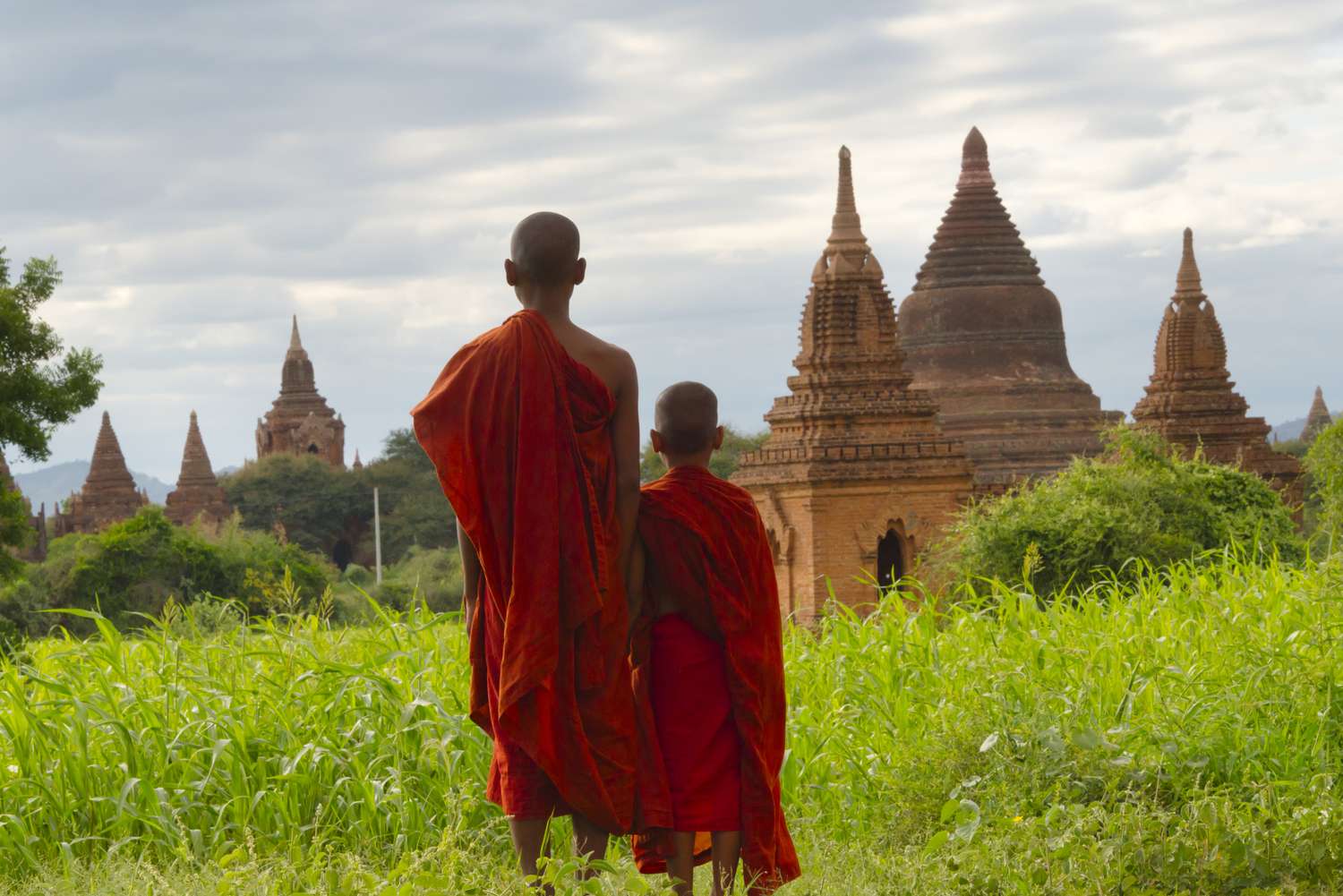Grab your thinking caps and get ready for a mind-boggling adventure into the world of Buddhist history in China! We’re going to uncover how these folks have been jotting down, making sense of, and passing on the story of their beliefs for centuries. It’s a wild mix of religion and history, so buckle up and let’s dive in!
Buddhist Historiography: Unraveling Buddhism’s Journey
Let’s dive into the fascinating world of Buddhist historiography, the study of how Buddhism’s history has been written, explored, and understood throughout time. It delves into the minds of those who lived through and documented these incredible stories.
Think of it like piecing together your family history from old photos, letters, and stories passed down through generations. Buddhist historiography uses records and writings to assemble the puzzle of Buddhism’s past. Like family stories, different versions, interpretations, and maybe even a few embellished tales exist!
A Unique Perspective on History
What makes Buddhist historiography especially interesting is its focus on understanding not just what happened, but why it happened through a Buddhist lens. Key ideas like karma (actions have consequences) and dharma (the Buddha’s teachings) are woven into these historical narratives.
It’s like viewing history through a specific filter—in this case, the filter of Buddhist beliefs. This approach adds depth and meaning to understanding the past.
Key Themes in Chinese Buddhist Historiography
Chinese Buddhist historiography, in particular, is filled with captivating stories and perspectives. Some key themes that often emerge include:
Karma and Causality: This theme explores how Buddhist historians viewed cause and effect in historical events, almost like a cosmic domino effect. They searched for connections and patterns, seeking to understand how past actions led to present circumstances within the framework of Buddhist teachings.
Prophecy and Legitimacy: Imagine prophecies as ancient PR campaigns. Buddhist historians often used prophecies to legitimize important figures and institutions, demonstrating their significance and connection to the divine. It’s fascinating to see how these prophecies shaped public perception and support for Buddhism.
Hagiography and Idealized Pasts: Hagiography, or writing about saints or holy figures, served as ancient inspirational biographies. While not always perfectly accurate, these stories promoted Buddhist values and presented role models for people to aspire to.
Political Patronage and Persecution: The relationship between Buddhist communities and Chinese rulers has been a rollercoaster—sometimes supportive, other times marked by conflict. Buddhist historiography helps us understand how these power dynamics impacted the spread and practice of Buddhism in China.
John Kieschnick: A Leading Voice
Scholar John Kieschnick has greatly contributed to our understanding of Buddhist historiography. His book, “Buddhist Historiography in China“, is a must-read for those interested in this subject. Kieschnick points out that Chinese Buddhist historians weren’t simply recording history—they actively shaped narratives, often to legitimize their institutions or understand the past through a Buddhist worldview. It’s a reminder that perspectives influence historical accounts.
The Future of Buddhist Historiography
The study of Chinese Buddhist historiography is far from over! Countless stories are waiting to be unearthed and interpreted. Researchers are making fascinating discoveries in areas like:
Comparative Perspectives: Scholars are comparing Buddhist historiography in China to records from other regions where Buddhism flourished. This cross-cultural lens helps us understand how different cultures shaped and were shaped by Buddhist teachings.
Modern Interpretations: How do modern scholars and practicing Buddhists interpret these ancient narratives? Exploring contemporary perspectives bridges the gap between the past and present, revealing how these stories still resonate today.
Digital Frontiers: Digitized Buddhist texts open up new avenues for research, allowing scholars to make connections and uncover hidden patterns in ways never before possible.
An Ongoing Exploration
Buddhist historiography is constantly evolving, enriched by new discoveries and interpretations. It reminds us that history is not just a collection of facts—it’s a tapestry woven from various perspectives and experiences.
The next time you encounter a story from Buddhist history, remember there’s often more beneath the surface. Consider the cultural context, the authors’ motivations, and the power of these narratives to shape our understanding of Buddhism’s rich and complex past.
Unlocking Historical Evidence of Buddhism
How do we know about Buddhism from centuries ago? What evidence illuminates its historical journey? Luckily, clues left behind piece together Buddhism’s past.
Ancient Texts and Inscriptions
One of the most significant pieces of evidence is the Pali Canon, a collection of ancient writings considered the earliest teachings and stories about the Buddha. They offer a glimpse into his world and the core ideas he shared.
Emperor Ashoka, in the 3rd century BCE, famously had grand pronouncements carved onto pillars and rocks throughout his kingdom. These inscriptions aren’t just etched words; they’re tangible proof of Buddhism’s flourishing under his rule.
Archaeological Discoveries
Archaeological digs at sites like Sanchi and Ajanta in India have unearthed remnants of magnificent stupas, sprawling monasteries, and intricate sculptures, all whispering tales of how Buddhism was practiced and expressed through art and architecture.
Travel Diaries
Travel diaries, like those of Chinese pilgrims Faxian and Xuanzang, who journeyed to the Indian subcontinent, provide firsthand accounts of Buddhist practices and impressive sites. Their records offer an outsider’s perspective on Buddhism’s diverse expressions.
Piecing Together the Puzzle
These historical treasures—texts, inscriptions, archaeological finds, and travelogues—paint a picture of Buddhism’s origins with Siddhartha Gautama’s quest for enlightenment, its growth in India under Emperor Ashoka, and its transformation as it traveled along the ancient Silk Roads.
It’s essential to remember that historical understanding is always evolving. New discoveries lead to fresh interpretations and challenge existing knowledge. Studying the past is an ongoing journey of discovery.
Deciphering the Buddhist Worldview
Beyond specific beliefs, Buddhism offers a worldview—a way of seeing life, the universe, and everything. It’s a practical guide for dealing with life’s ups and downs and finding inner peace. Buddhism emphasizes personal responsibility for one’s actions, thoughts, and feelings.
Imagine life as a journey. Buddhism provides a map and tools to navigate challenges and reach lasting happiness. This path is about understanding yourself and the world around you deeply.
Karma and Rebirth
The concept of karma in Buddhism suggests that our actions, whether good or bad, generate energy that influences our future, even in future lives. It’s a reminder to be mindful of our choices, as positive actions are believed to create positive energy, while negative actions can lead to unfavorable outcomes.
The Four Noble Truths
At the heart of Buddhism are the Four Noble Truths:
- Life has suffering: This truth acknowledges that everyone experiences suffering in different ways, whether physical, emotional, or existential.
- Clinging causes suffering: This truth suggests that much of our suffering stems from clinging to desires, aversions, and the desire for things to be different than they are.
- Ending clinging ends suffering: This truth offers hope by suggesting that letting go of attachments can lead to greater peace and happiness.
- The Eightfold Path leads to the end of suffering: This truth provides a practical roadmap for achieving liberation from suffering.
The Eightfold Path
The Eightfold Path outlines guidelines for living a more mindful, ethical, and fulfilling life. It’s not about perfection but about striving to live by these principles:
- Right Understanding: Cultivating wisdom and understanding of Buddhist teachings.
- Right Thought: Developing kind and compassionate thoughts.
- Right Speech: Speaking truthfully and kindly.
- Right Action: Acting ethically and compassionately.
- Right Livelihood: Earning a living ethically.
- Right Effort: Cultivating positive qualities.
- Right Mindfulness: Paying attention to the present moment.
- Right Concentration: Developing focus and mental clarity.
Meditation and Mindfulness
Meditation is a central practice in Buddhism, training the mind to be more focused, calm, and clear. It involves observing thoughts and feelings without judgment, allowing for greater awareness and peace.
Mindfulness extends meditation into everyday life, bringing present-moment awareness to all activities.
A Journey of Self-Discovery
Buddhism offers a rich perspective on life, acknowledging suffering while providing tools for transformation. It’s a path of learning, self-reflection, and compassion, offering timeless wisdom relevant in the modern world.
Buddhism: A Journey Through Time
Let’s explore the journey of Buddhism, from its origins to its global presence today.
Origins in Ancient India (5th Century BCE)
Buddhism emerged in a time of spiritual and philosophical change in ancient India. People sought new paths beyond the dominant Vedic traditions. Siddhartha Gautama, a prince, famously renounced his privileged life to seek enlightenment, becoming known as the Buddha, “the Awakened One.”
The Buddha’s Teachings
The Buddha’s teachings centered around the Four Noble Truths, emphasizing the reality of suffering, its causes, and the path to liberation. The Eightfold Path, encompassing ethical conduct, mental discipline, and wisdom, became a guide for achieving this liberation.
Ashoka’s Embrace and the Spread of Buddhism
Emperor Ashoka’s conversion to Buddhism in the 3rd century BCE marked a turning point. He actively promoted Buddhist teachings through missionaries and edicts, expanding its reach beyond India. Buddhism traveled along the Silk Road, reaching Central Asia, China, and Southeast Asia through trade and cultural exchange.
The Evolution of Schools
As Buddhism spread, it adapted to different cultures, leading to various schools of thought and practice. Major branches include Theravada Buddhism, prominent in Southeast Asia, and Mahayana Buddhism, prevalent in East Asia.
Buddhism Today
Today, Buddhism is a global religion with millions of followers. It continues to evolve, adapting to contemporary challenges and integrating with modern psychology and mindfulness practices.
Conclusion
Buddhist historiography offers a captivating lens through which to explore the rich history of Buddhism. From ancient texts to archaeological discoveries, a tapestry of evidence reveals the enduring impact of Buddhist teachings and practices. Understanding this history deepens our appreciation for Buddhism’s profound insights into the human condition and its enduring relevance in the modern world.
- Unlocking Francis Alexander Shields’ Finance Empire: A Comprehensive Biography - July 12, 2025
- Unveiling Francis Alexander Shields: A Business Legacy - July 12, 2025
- Francis Alexander Shields’ Business Career: A Comprehensive Overview - July 12, 2025















